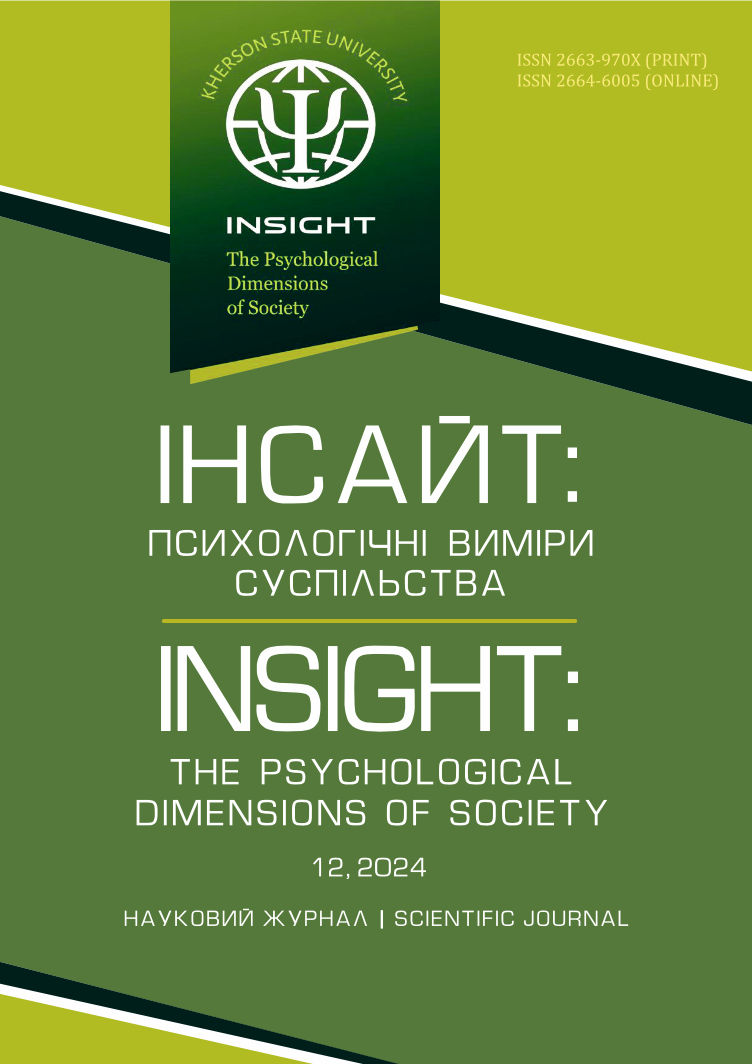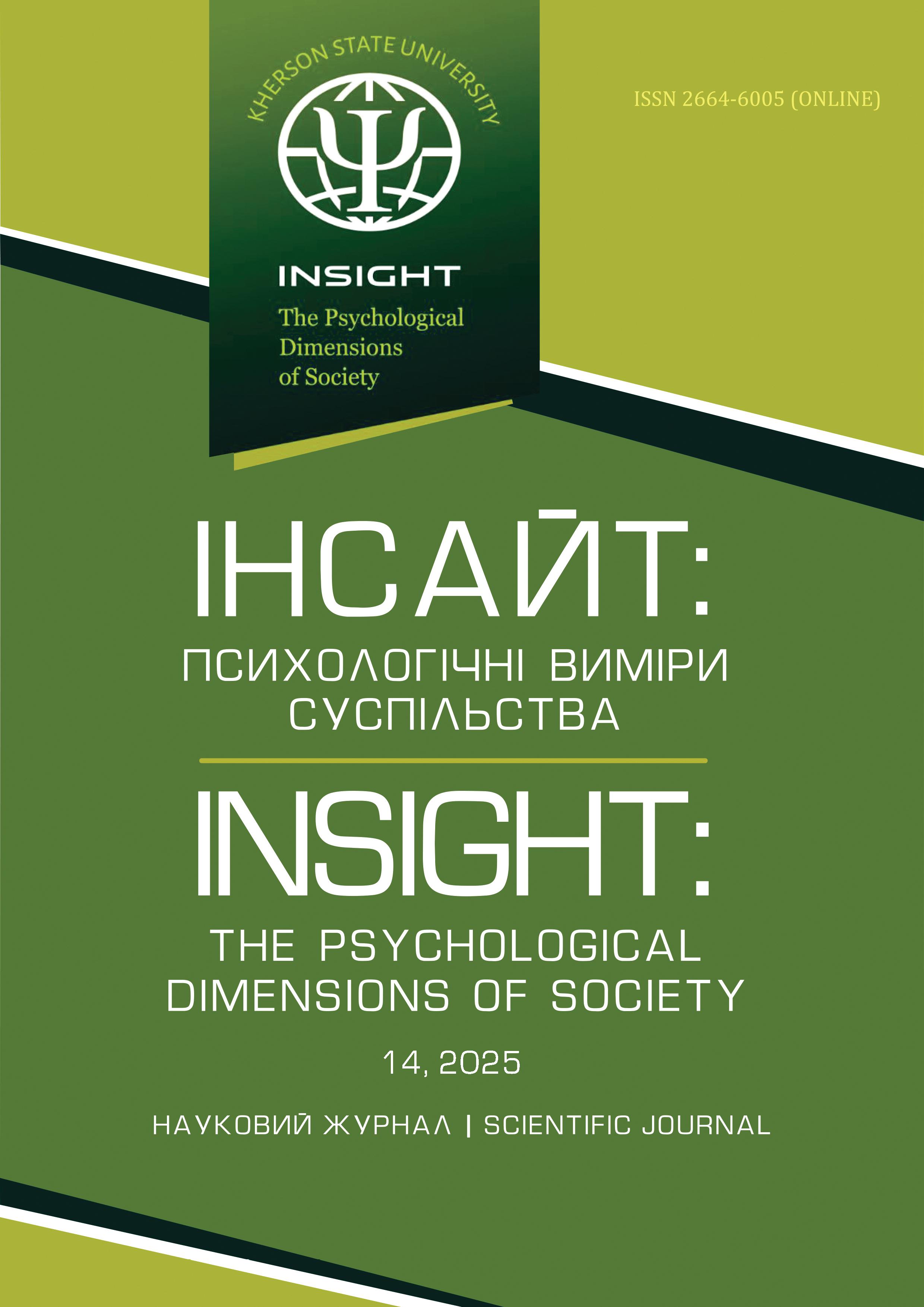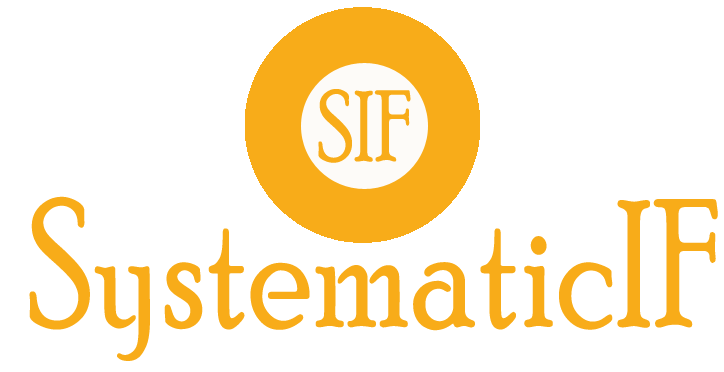Adaptive Potential of Adults with Attention Deficit/Hyperactivity Disorder (ADHD)
Abstract
The aim was a theoretical-empirical study of the adaptive potential of adults with attention deficit/hyperactivity disorder (ADHD). Methods. The sample consisted of adults with ADHD, totaling n = 32, of which n = 16 were female (50.00%) and n = 16 were male (50.00%). The participants’ ages ranged from 20 to 54 years (M = 36.12; Me = 36.00; SD = ± 8.43). A theoretical-empirical complex of methods was used, which included theoretical methods: retrospective analysis, synthesis, comparison, and generalization, as well as empirical methods: “The Work and Social Adjustment Scale” (W&SAS) (Mundt et al., 2002); “Zung Self-Rating Depression Scale” (ZSDS) (Zung, 1965); “Impact of Even Scale – Revised” (IES-R) (Sveen et al., 2010); “Generalized Anxiety Disorder Assessment Scale” (GAD-7) (Spitzer et al., 2006; adapted by N. Aleksina et al., 2024) and “New Methodology for Diagnosing Psychosocial Maladjustment” (NDMPM) (Herasymenko, 2018). Results and discussion. It was established that the parameter “work” has statistically significant correlations with depressiveness, anxiety disorders, and types of responses to traumatic events (p < .001). It was noted that the area where participants feel most comfortable is “personal leisure”, which is associated with the protective response of avoidance and anxiety disorders. It was argued that avoidance, as a defense mechanism and type of response to a traumatic event, only increases the tendency towards isolation and distancing. It was suggested that a constructive organization of the workspace for individuals with ADHD would enhance their adaptive capacity. Conclusions. The study of the adaptive potential of adults with ADHD revealed significant patterns of work and social adaptation among the participants. It was summarized that acceptance and support from the environment are crucial; tolerance and the absence of stigma within the family, workplace, and society at large had a positive effect; isolation is partly accompanied by a lack of support, which can lead to severe manifestations of ADHD and comorbid disorders; the impact of traumatic events was reflected in the mental states of the participants.
Downloads
References
Adler L. A., Anbarasan D., Leon T., Sardoff T., Descorbeth O., Cho D., Stern Y., Kraft O., Hendler T., Marmar C. R. Pilot Study of Prism EFP NeuroFeedback in Adult ADHD. Journal of Attention Disorders. 2024. Vol. 28(5). P. 905–912. https://doi.org/10.1177/10870547231215283
Ayers-Glassey S., Smilek D. The relations between hyperfocus and similar attentional states, adult ADHD symptoms, and affective dysfunction. Current Psychology. 2024. Vol. 43. P. 11254–11266. https://doi.org/10.1007/s12144-023-05235-3
Bondarchuk O., Balakhtar V., Pinchuk N., Pustovalov I., Pavlenok K. Adaptation of Coping Strategies to Reduce the Impact of Stress and Lonelines on the Psychological Well-Being of Adults. Journal of Law and Sustainable Development. 2023. Vol. 11(10). e1852. https://doi.org/10.55908/sdgs.v11i10.1852
Callen E. F., Clay T., Alai J., Goodman D. W., Adler L. A., Faraone S. V. The Role of Age in Adult ADHD Quality Care: A Longitudinal Analysis of Electronic Health Record Data. Journal of Attention Disorders. 2024. Vol. 28(5). P. 913–922. https://doi.org/10.1177/10870547231218042
Caroline S., S. S., Sudhir P. M., Mehta U. M., Kandasamy A., Thennarasu K., Benegal V. Assessing Adult ADHD: An Updated Review of Rating Scales for Adult Attention Deficit Hyperactivity Disorder (ADHD). Journal of Attention Disorders. 2024. Vol. 28(7). P. 1045–1062. https://doi.org/10.1177/10870547241226654
Dahlan R M. Social Adaptation, Self-Confidence and their Relation to Student Achievement Motivation of Madrasa Senior High School 1 Bogor Indonesia in Generating Student with Character. Opción. 2019. Vol. 35. P. 841–863. URL: https://produccioncientificaluz.org/index.php/opcion/article/view/29670
Danielson M. L., Claussen A. H., Arifkhanova A., Gonzalez M. G., Surman C. Who Provides Outpatient Clinical Care for Adults With ADHD? Analysis of Healthcare Claims by Types of Providers Among Private Insurance and Medicaid Enrollees. Journal of Attention Disorders. 2024. Vol. 28(8). P. 1225–1235. https://doi.org/10.1177/10870547241238899
Enriquez‐Urzelai U., Palacio A. S., Merino N. M., Sacco M., Nicieza A. G. Hindered and constrained: limited potential for thermal adaptation in post‐metamorphic and adult Rana temporaria along elevational gradients. Journal of Evolutionary Biology. 2018. Vol. 31(12). P. 1852–1862. https://doi.org/10.1111/jeb.13380
First J. M., Yu M., Houston J. B. The Disaster Adaptation and Resilience Scale: development and validation of an individual-level protection measure. Disasters. 2021. Vol. 45(4). P. 939–967. https://doi.org/10.1111/disa.12452
Fullerton D. J., Zhang L. M., Kleitman S. An Integrative Process Model of Resilience in an Academic Context: Resilience Resources, Coping Strategies, and Positive Adaptation. Plos One. 2021. Vol. 16. e0246000. https://doi.org/10.1371/journal.pone.0246000
Herasymenko L. А. A new method of diagnosis of psychosocial maladjusment. Likars’ka Sprava. 2018. Vol. 1–2. P. 82–88. https://doi.org/10.31640/JVD.1-2.2018(14)
Hrys A., Popovych I., Zelenko O., Pavliuk M., Fedorenko L., Prachenko O., Huzar V. Time decentrations of junior athletes under changed conditions of competitive activity. Journal of Physical Education and Sport. 2024. Vol. 24(1). P. 13–22. https://doi.org/10.7752/jpes.2024.01002
Hutt Vater C., DiSalvo M., Ehrlich A., Parker H., O’Connor H., Faraone S. V., Biederman J. ADHD in Adults: Does Age at Diagnosis Matter? Journal of Attention Disorders. 2024. Vol. 28(5). P. 614–624. https://doi.org/10.1177/10870547231218450
Jakobsson Støre S., Van Zalk N., Granander Schwartz W., Nilsson V., Tillfors M. The Relationship Between Social Anxiety Disorder and ADHD in Adolescents and Adults: A Systematic Review. Journal of Attention Disorders. 2024. Vol. 28(9). P. 1299–1319. https://doi.org/10.1177/10870547241247448
Jen-Yi L., Krishnasamy M., Der-Thanq C. Research with persons with intellectual disabilities: An inclusive adaptation of Tourangeau’s model. Alter. 2015. Vol. 9(4). P. 304–316. https://doi.org/10.1016/j.alter.2015.07.006
Katzman M. A., Bilkey T. S., Chokka P. R., Fallu A., Klassen L. J. Adult ADHD and comorbid disorders: clinical implications of a dimensional approach. BMC psychiatry. 2017. Vol. 17. Article number: 302. https://doi.org/10.1186/s12888-017-1463-3
Knouse L. E., Mitchell J. T. Incautiously Optimistic: Positively-Valenced Cognitive Avoidance in Adult ADHD. Cognitive and Behavioral Practice. 2015. Vol. 22(2). P. 192–202. https://doi.org/10.1016/j.cbpra.2014.06.003
Кокун О. М. Оптимізація адаптаційних можливостей людини: психофізіологічний аспект забезпечення діяльності. Київ: Міленіум. 2004. 265 с. URL: https://lib.iitta.gov.ua/id/eprint/1513
Kroenke K., Spitzer R. L., Williams J. B. The PHQ-9: validity of a brief depression severity measure. Journal of General Internal Medicine. 2001. Vol. 16(9). P. 606 – 613. https://doi.org/10.1046/j.1525-1497.2001.016009606.x
Krtkova R., Krtek A., Pesoutova M., Meier Z., Tavel P., Malinakova K., Trnka R. What influences do parents perceive as supportive of school well-being and the inclusion of children with ADHD?: A qualitative study. European Journal of Special Needs Education. 2022. Vol. 38(2). P. 218–232. https://doi.org/10.1080/08856257.2022.2050972
Maksymova N. Y., Hrys A., Pavliuk M. M., Maksymov M. V., Ivantsev N. I. Environmental Friendliness of a Person’s Musical Space as a Factor of Personality Disharmony Prevention. Journal of Intellectual Disability – Diagnosis and Treatment. 2021. Vol. 9(6). P. 667–675. https://doi.org/10.6000/2292-2598.2021.09.06.9
Mattos P., Moraes C. E. F. de Sichieri R., Hay P., Faraone S. V., Appolinario J. C. Adult ADHD Symptoms in a Large Metropolitan Area from Brazil: Prevalence and Associations with Psychiatric Comorbidity, Bullying, Sexual Abuse, and Quality of Life. Journal of Attention Disorders. 2024. Vol. 28(7). P. 1082–1091. https://doi.org/10.1177/10870547241229097
Mundal I., Schei J., Lydersen S., Thomsen P. H., Novik T. S., Kvitland L. R. Prevalence of chronic and multisite pain in adolescents and young adults with ADHD: a comparative study between clinical and general population samples (the HUNT study). European Child & Adolescent Psychiatry. 2024. Vol. 33. P. 1433–1442. https://doi.org/10.1007/s00787-023-02249-x
Mundt J. C., Marks I. M., Shear M. K., Greist J. H. The Work and Social Adjustment Scale: a simple measure of impairment in functioning. British Journal of Psychiatry. 2002. Vol. 180. P. 461–464. https://doi.org/10.1192/bjp.180.5.461
Nagatsuka Y., Nakamura D., Ota M., Arai G., Iwami Y., Suzuki H. Gaze measurements during viewing human dialogue scenes in adults with ADHD: Preliminary findings. Neuropsychopharmacology Reports. 2024. Vol. 44. P. 73–79. https://doi.org/10.1002/npr2.12383
Ogrodnik M., Karsan S., Malamis B., Kwan M., Fenesi B., Heisz J. J. Exploring Barriers and Facilitators to Physical Activity in Adults with ADHD: A Qualitative Investigation. Journal Developmental and Physical Disabilities. 2023. Vol. 36. P. 307–327 (2024). https://doi.org/10.1007/s10882-023-09908-6
Olesen E. Overcoming Diagnostic Uncertainty: Clinicians, Patients and Institutional Work in Practice. Scandinavian Journal of Disability Research. 2019. Vol. 21(1). P. 186–196. https://doi.org/10.16993/sjdr.638
Пінас Н., Грись, А. Соціально-психологічні чинники адаптації осіб дорослого віку із РДУГ. Наукові праці Міжрегіональної Академії управління персоналом. Психологія. 2024. № 1(62). С. 15–24. https://doi.org/10.32689/maup.psych.2024.1.3
Park S., Park S. Prevalence, Correlates, and Comorbidities Among Young Adults Who Screened Positive for ADHD in South Korea During the COVID-19 Pandemic. Journal of Attention Disorders. 2024. Vol. 28(9). P. 1331–1339. https://doi.org/10.1177/10870547241253151
Pedersen A. B., Edvardsen B. V., Messina S. M., Volden M. R., Weyandt L. L., Lundervold A. J. Self-Esteem in Adults with ADHD Using the Rosenberg Self-Esteem Scale: A Systematic Review. Journal of Attention Disorders. 2024. Vol. 28(7). P. 1124–1138. https://doi.org/10.1177/10870547241237245
Popovych I., Hrys A., Hoian I., Mamchur I., Babenko A., Fedyk O. Successfulness in teenagers’ sporting activities: comparative analysis of individual and team sports. Journal of Physical Education and Sport. 2022a. Vol. 22(11). P. 2886–2897. https://doi.org/10.7752/jpes.2022.11365
Popovych I., Kosmii M., Hrys A., Hoi N., Dyhun I., Hoian I., Nosov P. Pre-competition expectation profiles among junior athletes in the context of altered sporting conditions. Journal of Physical Education and Sport. 2023. Vol. 23(10). P. 2551–2562. https://doi.org/10.7752/jpes.2023.10293
Popovych I., Kurova A., Koval I., Kazibekova V., Maksymov M., Huzar V. Interdependence of emotionality, anxiety, aggressiveness and subjective control in handball referees before the beginning of a game: a comparative analysis. Journal of Physical Education and Sport. 2022b. Vol. 22(3). P. 680–689. https://doi.org/10.7752/jpes.2022.03085
Popovych I. S., Blynova O. Ye. The Structure, Variables and Interdependence of the Factors of Mental States of Expectations in Students’ Academic and Professional Activities. The New Educational Review. 2019. Vol. 55(1). P. 293–306. https://doi.org/10.15804/tner.2019.55.1.24
Popovych I., Zavatskyi V., Tsiuniak O., Nosov P., Zinchenko S., Mateichuk V., Zavatskyi Yu., Blynova O. Research on the Types of Pre-game Expectations in the Athletes of Sports Games. Journal of Physical Education and Sport. 2020. Vol. 20(1). P. 43–52. https://doi.org/10.7752/jpes.2020.01006
Prokhorenko L., Popovych I., Sokolova H., Chumaieva Yu., Kosenko Yu., Razumovska T., Zasenko V. Gender differentiation of self-regulating mental states of athletes with disabilities: comparative analysis. Journal of Physical Education and Sport. 2023. Vol. 23(2). P. 349–359. https://doi.org/10.7752/jpes.2023.02042
Richard V., Lebeau J.-C., Becker F., Inglis E. R., Tenenbaum G. Do more creative people adapt better? An investigation into the association between creativity and adaptation. Psychology of Sport and Exercise. 2018. Vol. 38. P. 80–89. https://doi.org/10.1016/j.psychsport.2018.06.001
Selye H. A. Confusion and Controversy in the Stress Field. Journal of Human Stress. 1975. Vol. 1. Р. 37–44. http://dx.doi.org/10.1080/0097840X.1975.9940406
Shcherbak T., Popovych I., Kariyev A., Duisenbayeva A., Huzar V., Hoian I., Kyrychenko K. Psychological causes of fatigue of football players. Journal of Physical Education and Sport. 2023. Vol. 23(8). P. 2193–2202. https://doi.org/10.7752/jpes.2023.08251
Spitzer R. L., Kroenke K., Williams J. B. W., Löwe B. A Brief Measure for Assessing Generalized Anxiety Disorder: The GAD-7. Archives of Internal Medicine. 2006. Vol. 166(10). P. 1092–1097. https://doi.org/10.1001/archinte.166.10.1092
Sprich S. E., Knouse L. E., Cooper-Vince C., Burbridge J., Safren S. A. Description and Demonstration of CBT for ADHD in Adults. Cognitive and Behavioral Practice. 2010. Vol. 17(1). P. 9–15. https://doi.org/10.1016/j.cbpra.2009.09.002
Sveen J., Low A., Dyster-Aas J., Ekselius L., Willebrand M., Gerdin B. Validation of a Swedish version of the Impact of Event Scale-Revised (IES-R) in patients with burns. Journal of Anxiety Disorders. 2010. 24(6). P. 618–622. https://doi.org/10.1016/j.janxdis.2010.03.021
Tkalych M. H. Psychoemotional states and vitality: psychological adaptation during wartime. In: Psychological patterns of social processes and personality development in modern society: Scientific monograph. Riga, Latvia: “Baltija Publishing”, 2023. P. 230–243. https://doi.org/10.30525/978-9934-26-326-2-13
Waldren L. H., Leung F. Y. N., Hargitai L. D., Burgoyne A. P., Liceralde Van R. T., Livingston L. A., Shah P. Unpacking the overlap between Autism and ADHD in adults: A multi-method approach. Cortex. 2024. Vol. 173. P. 120–137. https://doi.org/10.1016/j.cortex.2023.12.016
Wang Y.-H., Gau S.-F., Yang L.-K., Chang J.-C., Cheong P.-L., Kuo H.-I. Acute aerobic exercise at different intensities modulates inhibitory control and cortical excitability in adults with attention-deficit hyperactivity disorder (ADHD). Asian Journal of Psychiatry. 2024. Vol. 95. P. 103993. https://doi.org/10.1016/j.ajp.2024.103993
Zung W. W. A self-rating depression scale. Archives of General Psychiatry. 1965. Vol. 12, 63–70. https://doi.org/10.1001/archpsyc.1965.01720310065008
Authors who publish with scientific journal agree to the following terms:
• All scientific papers may be freely copied and distributed on any medium and in any format, provided that the references to the initial data of the scientific work are indicated.
• Authors retain copyright and grant the journal right of first publication with the work simultaneously licensed Creative Commons Attribution License .
• Authors are able to enter into separate, additional contractual arrangements for the non- exclusive distribution of the journal’s published version of the work (institutional repository, your website, monograph), with an acknowledgement of its initial publication in this journal.





































